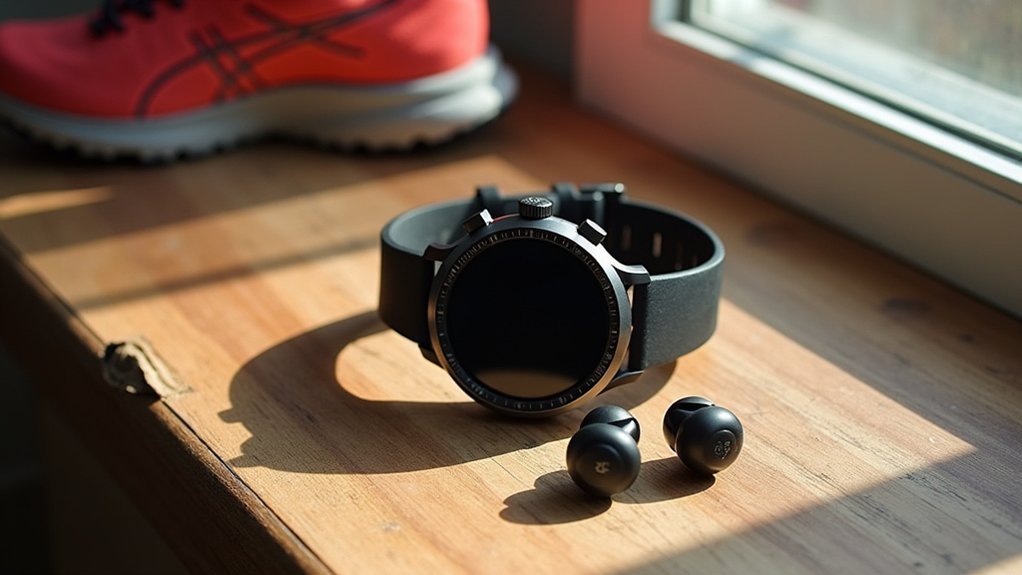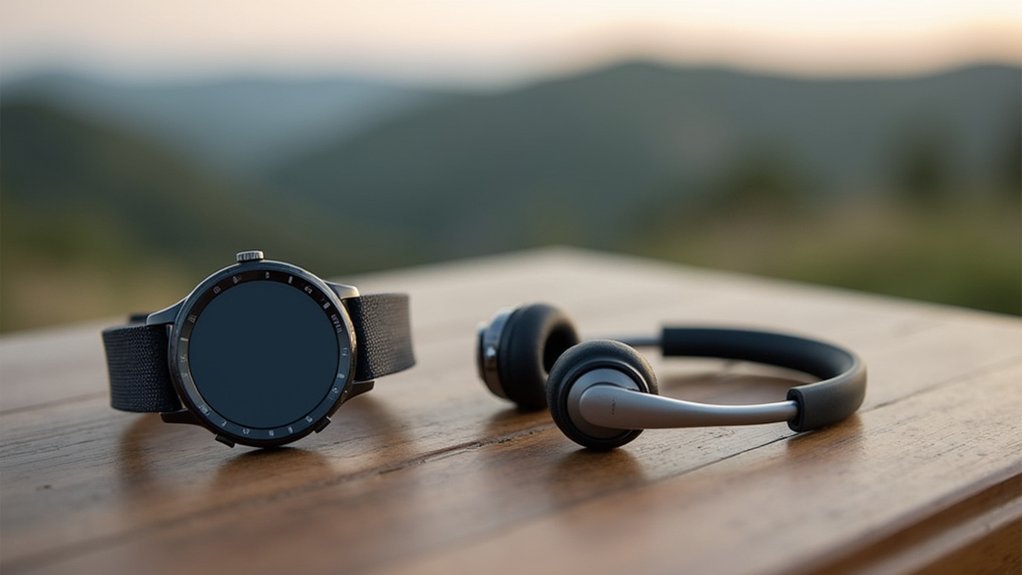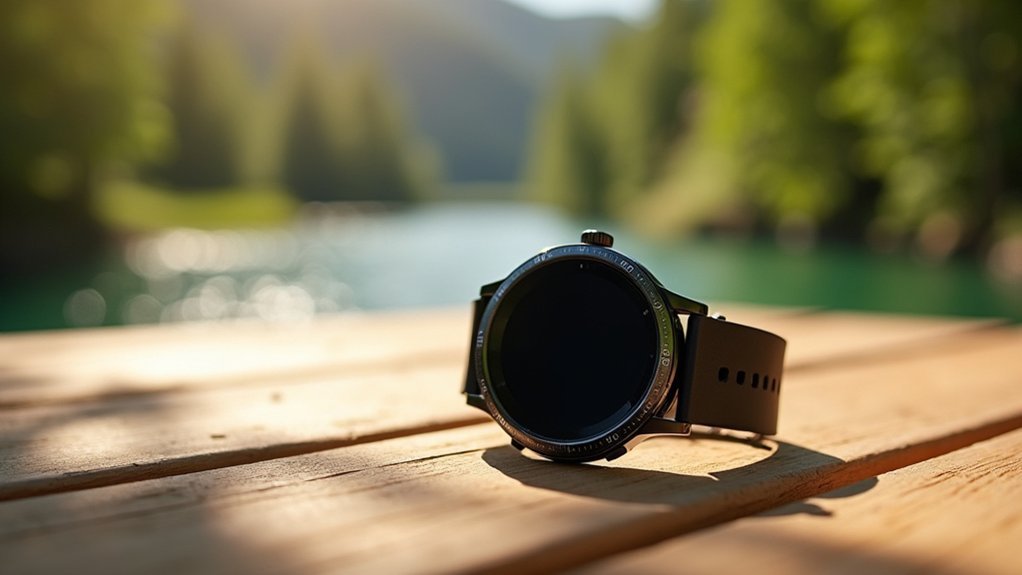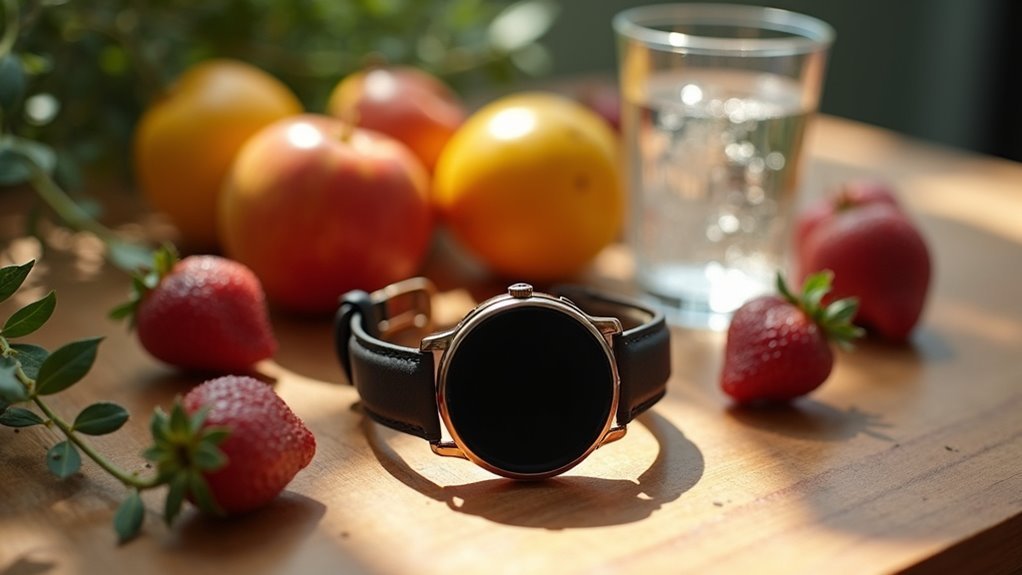You can stream music on your Suunto 7 through Spotify integration via Google Play Store, which requires Wear OS 2.0 or higher. With Spotify Premium, you’ll download playlists and podcasts for offline playback, while non-premium users face shuffle-only limitations. Pair compatible Bluetooth headphones like Suunto Wing or Sonic for direct watch playback, though battery life drops from 10-12% to 30% per hour during streaming. Music controls integrate seamlessly into your exercise interface for easy access during workouts, and there’s much more to optimize your setup.
Suunto 7 Spotify Integration and Premium Features

When you’re ready to cut the cord from your smartphone during workouts, the Suunto 7’s Spotify integration delivers exactly what you need.
You’ll find the Spotify app available through the Google Play Store, requiring Wear OS 2.0 or higher for full functionality.
With a Spotify Premium account, you can download albums, playlists, and podcasts directly to your watch for offline playback. This means you’ll enjoy music during outdoor activities without Wi-Fi or cellular connections.
Premium subscribers can store their favorite music and podcasts directly on the watch for truly wireless workout sessions.
Premium users get full control over song selection and playback, while non-premium users face limitations like shuffle-only streaming.
You’ll see a green arrow indicator for downloaded content in the watch’s Spotify app.
The integration specifically targets fitness enthusiasts who want seamless music access during their workouts. Music can help maintain a consistent pace by syncing your movement to the rhythm during training sessions.
Offline Music Storage and Download Requirements
Storage capacity becomes the deciding factor when selecting a Suunto watch for offline music playbook. The Suunto Run offers 4GB dedicated to offline music storage, making it your primary option for music features.
However, you’re limited to MP3 format only—no AAC or FLAC support. You’ll need to transfer files manually via wired connection or Bluetooth pairing since streaming services like Spotify can’t download directly to the watch.
The discontinued Suunto 7 previously supported this functionality, but current models like the Race and Vertical prioritize map storage over music capabilities. These watches feature dual-band GNSS technology for enhanced accuracy during outdoor activities.
Before purchasing, verify your specific model’s storage specifications and transfer requirements. You’ll likely need third-party apps for file management since native OS support isn’t guaranteed across all Suunto models.
Setting Up Bluetooth Headphones for Direct Watch Playback

Once you’ve loaded music onto your Suunto watch, you’ll need compatible Bluetooth headphones to enjoy wireless playback directly from your wrist. While any Bluetooth headphones with A2DP profile support can work, Suunto Wing and Suunto Sonic headphones are specifically tested for direct compatibility.
| Headphone Model | Pairing Method |
|---|---|
| Suunto Wing | Hold button 3 seconds, then 2 more until red LED blinks |
| Suunto Sonic | Hold button 3 seconds, then 2 more until red/white LED flashes |
Navigate to your watch’s Bluetooth settings and select “Connect Devices.” When your watch enters discovery mode, select your headphones from the available devices list. Confirm pairing on both devices if prompted. Once connected successfully, audio will route directly from your watch to your headphones.
Your Suunto Wing headphones can connect to two devices simultaneously, allowing you to maintain connection to both your watch and phone if needed.
Battery Life Impact of Music Streaming and Playback
You’ll notice your Suunto watch’s battery drains much faster when streaming music, with consumption rates jumping from 10-12% per hour to around 30% per hour during playback.
This significant power draw means you’ll need to plan your charging schedule more carefully, especially if you’re heading out for longer workouts or activities. Just 20 minutes of charging provides enough power for 2 hours of training, making quick top-ups a viable strategy.
Managing your battery during exercise becomes essential since music playback prevents your watch from entering low power mode and can cut your GPS activity time in half.
Power Consumption During Streaming
While music streaming transforms your Suunto watch into a powerful entertainment device, it dramatically increases power consumption compared to standard activity tracking.
You’ll experience roughly 30% battery drop per hour when streaming music, compared to just 10-12% without it. This significant increase occurs because music playback prevents your watch from entering low power mode, forcing it to maintain higher energy consumption throughout use.
Both streaming and offline music playback affect battery life similarly, so downloading tracks won’t necessarily save power.
Bluetooth connectivity for audio transmission adds another layer of drain. Your actual consumption varies based on streaming service performance—apps like Spotify and YouTube Music have reported efficiency issues.
You’ll notice this impact across all Suunto models, making power management vital for extended use. Consider using NavMusic for better battery performance when playing music offline, as some users report more favorable battery consumption with this alternative.
Managing Battery During Exercise
Music streaming’s power demands become most apparent during exercise sessions, where every percentage point of battery life counts toward completing your workout.
You’ll experience roughly 30% battery drain per hour when streaming offline music, compared to just 10-12% without playbook—a threefold increase that can cut your workout short.
To extend battery life while keeping music, turn off continuous heart rate monitoring and reduce GPS accuracy settings.
Minimize map viewing and screen wake frequency, as these prevent low power mode activation. Consider charging during brief breaks like shower times to maximize available power.
For ultra-long sessions, limit music playbook to critical portions of your workout.
Your watch enters high power mode during streaming, blocking efficient battery states that normally conserve energy during exercise tracking. The Suunto Run’s always-on display option provides approximately four days of battery life when combined with daily workout sessions lasting one to two hours.
Music Controls and Interface During Sports Activities

During intense workouts, accessing music controls shouldn’t interrupt your training flow, and Suunto watches make this seamless by integrating media controls directly into your exercise interface.
Your Suunto 7, Suunto 9, or Suunto 5 automatically displays media controls when music starts on your paired phone, eliminating the need to fumble with devices mid-workout.
Seamless media control integration keeps your hands free and your workout momentum uninterrupted across all Suunto models.
You can pause tracks, skip songs, and adjust volume directly from your wrist without breaking stride. The Suunto 7 offers dedicated button shortcuts for even faster access during exercise.
Whether you’re running intervals or cycling, these controls work with any media type – music, podcasts, or audiobooks. Access the media controls by pressing the middle button until the display appears on your watch screen.
For enhanced functionality, services like Spotify provide dedicated apps that integrate perfectly with your workout routine, giving you complete control over your audio experience.
Limitations of Other Suunto Watch Models for Music
Beyond the convenient music controls available during workouts, you’ll encounter notable limitations if you’re considering older Suunto watch models for your music needs.
Models prior to the Suunto 7 and Race face considerable constraints that’ll impact your listening experience:
- Storage restrictions – You’re limited to 16-32GB primarily reserved for maps, leaving minimal space for music files.
- No streaming capabilities – Unlike Garmin competitors, you can’t access Spotify or other streaming services directly from your watch.
- Missing MP3 playback – Earlier models lack native audio file support, forcing you to rely on phone-based controls.
- Battery drain concerns – Music playback notably reduces battery life on devices optimized for sports tracking rather than media consumption. Additionally, features like Autolap may further reduce battery performance during extended activities.
These limitations mean you’ll need your phone nearby for actual music playback.
WiFi and Cellular Streaming Options for Non-Premium Users
You can stream Spotify on your Suunto 7 as a non-Premium user, but you’ll be limited to Shuffle Mode whether you’re connected via WiFi or cellular data.
Your watch needs a stable WiFi connection or cellular hotspot from your phone to maintain uninterrupted streaming during workouts. The media controls will appear automatically on top of your exercise views when music is playing, allowing you to manage playback without interrupting your workout.
Keep in mind that streaming over cellular will consume your phone’s data plan and may result in additional charges from your carrier.
Shuffle Mode Streaming
While Spotify Premium users enjoy unlimited track selection, non-Premium subscribers can still stream music on their Suunto 7 through Shuffle Mode.
You’ll access Spotify’s complete library but with random playback order instead of choosing specific tracks.
To stream in Shuffle Mode, you’ll need:
- Active internet connection – Either WiFi or cellular data on your watch
- Wear OS 2.0 or higher – Guarantees compatibility with Spotify streaming features
- Latest Spotify app version – Updated software prevents connectivity issues
- Paired Bluetooth headphones – Essential for audio output during workouts
Your watch streams directly over cellular when you’re away from WiFi, though this consumes significant data.
WiFi streaming conserves your cellular plan while providing the same shuffle experience. Streaming music is power-intensive and will drain your watch battery faster than normal use.
WiFi Connection Requirements
For non-Premium Spotify users, your Suunto 7’s streaming capabilities depend entirely on establishing a reliable internet connection through WiFi or your paired smartphone.
You’ll need to manually enable WiFi in your watch settings and connect to saved or known networks. Since your Suunto lacks cellular connectivity, you can’t stream independently without these connections.
WiFi offers faster data transfer than using your phone as an intermediary, making it ideal for streaming. However, it’ll drain your battery more quickly.
Your watch automatically chooses the best available connection when both WiFi and phone options exist. You can check connectivity status by swiping down on the watch face to view connection indicators. Remember to pair Bluetooth headphones for audio output, and be cautious with public WiFi networks that may compromise your data security.
Cellular Data Usage
When streaming music through cellular data on your Suunto watch, you’ll face several important considerations that directly impact your experience.
Cellular streaming provides mobility without WiFi networks but comes with trade-offs you should understand.
Key cellular data considerations include:
- Battery drain increases considerably compared to WiFi streaming or offline playback, affecting longer exercise sessions.
- Data charges apply from your mobile carrier, so monitor usage to avoid unexpected costs.
- Audio quality affects consumption – higher quality streams use more data and power.
- Non-premium users get shuffle-only mode when streaming over cellular, limiting track control.
Your watch can stream through its own cellular connection or use your paired phone’s mobile data.
When both WiFi and cellular are available, your watch automatically prioritizes the faster WiFi connection.
Optimizing Music Setup for Long-Distance Training Sessions
Since long-distance training sessions can stretch for hours across remote terrain where connectivity becomes unreliable, you’ll need to strategically configure your Suunto 7’s music setup to maintain consistent audio throughout your workout.
Download playlists directly to your watch using Spotify Premium for guaranteed offline access. Pair your Bluetooth headphones before starting and verify they’re fully charged to match your session duration.
Battery management becomes critical—music playback and Bluetooth connectivity drastically reduce watch life to just a few hours. Combat this by reducing screen brightness, disabling unused functions, and carrying a portable charger for ultra-long sessions. For non-Premium users, convert your Spotify tracks using DRmare Spotify Music Converter to create compatible files that can be uploaded through YouTube Music for offline playback.
Create curated playlists that match your training intensity and duration for peak motivation and pacing throughout your entire workout.
Frequently Asked Questions
Can I Transfer Music From My Computer to the Suunto 7?
Yes, you can transfer music from your computer to the Suunto 7. Connect it via USB cable, then use iTunes or Windows Media Player to sync your desired songs directly to the watch.
Does the Suunto 7 Support Music Apps Other Than Spotify?
You can’t use other music apps for streaming or offline playback on Suunto 7. YouTube Music only works as a phone remote, while Apple Music and Amazon Music lack dedicated watch apps entirely.
What Audio File Formats Are Compatible With the Suunto 7?
You can play MP3, AAC, WAV, and FLAC audio files on your Suunto 7. These standard formats work for offline playback, but DRM-protected files from streaming services won’t play directly.
Can I Use Wired Headphones With the Suunto 7 Watch?
You can’t use wired headphones with the Suunto 7 because it doesn’t have an audio jack. You’ll need Bluetooth headphones to listen to music stored on your watch during workouts.
Is There a Storage Limit for Downloaded Music on the Watch?
You don’t face a fixed storage limit, but you’re constrained by available memory after apps and updates. You can store several thousand tracks depending on file sizes and remaining space.
In Summary
You’ll find the Suunto 7 offers solid music streaming capabilities, especially with Spotify Premium and offline storage. Remember to balance your music needs with battery life for longer activities, and make sure you’ve got reliable Bluetooth headphones paired. While other Suunto models won’t stream music directly, the Suunto 7’s integration makes it a solid choice if music’s essential to your training. Test your setup before important workouts to avoid surprises.





Leave a Reply